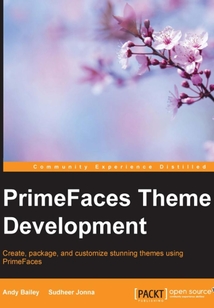目錄(115章)
倒序
- coverpage
- PrimeFaces Theme Development
- Credits
- About the Authors
- About the Reviewers
- www.PacktPub.com
- Support files eBooks discount offers and more
- Preface
- What this book covers
- What you need for this book
- Who this book is for
- Conventions
- Reader feedback
- Customer support
- Chapter 1. To Skin an App
- Why we need to create an app
- The PrimeFaces library
- Creating a NetBeans Maven JSF project
- Adding the PrimeFaces library and related dependencies to our project
- Building the project
- Running the project
- Summary
- Chapter 2. Introducing PrimeFaces Themes
- The difference between standard JSF and PrimeFaces components
- Adding additional PrimeFaces themes
- The PrimeFaces ThemeSwitcher component
- Creating the CurrentTheme Bean
- Extending the ThemeService Bean
- Creating a Facelets Template
- Creating a Mini Showcase page
- Adding buttons that change the theme without using ThemeSwitcher
- Summary
- Chapter 3. jQuery UI ThemeRoller and the Anatomy of a Theme
- jQuery UI and its standard CSS rules
- The difference between a layout and the look and feel of UI components
- How PrimeFaces uses the jQuery UI CSS rules
- Changing the initial font and font size
- Creating a theme and downloading it
- Comparing our theme to a PrimeFaces one
- Packaging and adding our custom theme to the project
- Adding the new theme to the ThemeSwitcher class
- Summary
- Chapter 4. A PrimeFaces inputText Component in Detail
- Creating a new JSF page and adding a standard inputText component
- Examining the UI element using the browser developer tool
- Adding a PrimeFaces inputText component to the page and comparing these two elements
- Turning a standard component into a PrimeFaces one
- Summary
- Chapter 5. Let's Get Creative
- Creating a new JSF page
- Using your unpackaged theme and applying it to your application
- Changing the initial font and font size in your theme
- Changing the foreground and background colors
- Changing the highlighted active and selected CSS rules
- Changing the rounding rules
- Changing the shadow effects
- Changing the menu background
- Summary
- Chapter 6. Icons
- Introducing the standard theme icon set
- Creating a set of icons of our own
- Adding the new icons to your theme
- Using custom icons in the commandButton components
- Using custom icons in a menu component
- The Font Awesome icons as an alternative to the ThemeRoller icons
- Summary
- Chapter 7. Dynamic Changes – a Working Example
- Introducing the schedule component
- A lack of skinning support for date and event selection
- Creating a CSS rule to set the background color in an HTML element
- Creating a JavaScript function to apply CSS rules to a specific HTML element
- Executing a client-side JavaScript function from the server-side – the power of AJAX and RequestContext
- Summary
- Chapter 8. Mobile Web Apps
- The demand of creating a powerful mobile website
- Restrictions of real estate mobile device screens are simply smaller
- Introducing PrimeFaces Mobile for JSF-based applications
- The differences between PrimeFaces Mobile and normal PrimeFaces
- Creating customized mobile themes – the power of jQuery Mobile ThemeRoller
- Applying customized mobile themes to PrimeFaces Mobile
- Summary
- Chapter 9. The Final Touches
- The PrimeFaces showcase
- See what you don’t like in the showcase and apply the changes
- See what you do like in the showcase and make everything look that way
- Do the changes same way for PrimeFaces Mobile
- Packaging your custom theme
- Creating CSS files that provide variations on a theme
- Summary
- Chapter 10. Theme Design Best Practices
- Introduction of WAI for good web design
- Colors icon sets background and foreground
- Fonts make the text stand out
- Rich Internet applications versus desktop applications
- Functions per page
- Components you will be using
- Some important PrimeFaces CSS classes
- Going beyond the standard PrimeFaces theme
- Override PrimeFaces CSS classes
- Override specific component CSS styles
- Preview the theme styles before going to use
- Considerations for mobile applications
- Busy UI versus data-dominated UI
- Feedback from potential users
- Miscellaneous best practices
- Summary
- Chapter 11. Premium Themes and Layouts and Third-party Converter Tools
- Introducing premium themes and layouts
- Setting up and installing premium themes
- Using CSS Less support to customize CSS styles easily
- Brand new themes based on Google Material Design language
- A brief coverage of different premium themes and layouts features
- Third-party theme converters
- Summary
- Index 更新時間:2021-07-09 21:12:44
推薦閱讀
- Bootstrap Site Blueprints Volume II
- 零基礎學C++程序設計
- ASP.NET Core 5.0開發入門與實戰
- 實用防銹油配方與制備200例
- 區塊鏈:以太坊DApp開發實戰
- WordPress Plugin Development Cookbook(Second Edition)
- Mastering Python Networking
- 軟件架構:Python語言實現
- Oracle Exadata專家手冊
- 西門子S7-200 SMART PLC編程從入門到實踐
- Creating Mobile Apps with jQuery Mobile(Second Edition)
- C++20高級編程
- 軟件工程基礎與實訓教程
- 大學計算機基礎實訓教程
- Java 9 with JShell
- Groovy 2 Cookbook
- 安卓工程師教你玩轉Android
- 編程風格:程序設計與系統構建的藝術(原書第2版)
- Python量子計算實踐:基于Qiskit和IBM Quantum Experience平臺
- Visual C++網絡編程教程(Visual Studio 2010平臺)
- 區塊鏈原理、架構與應用(第2版)
- 寫給所有人的編程思維
- 代碼整潔之道:程序員的職業素養
- R語言
- LibGDX Cross:Platform Development Blueprints
- 大規模Scrum:大規模敏捷組織的設計
- RESTful Web API Design with Node.js 10
- 高效C/C++調試
- 可編程控制器原理及應用
- C# 5 First Look


